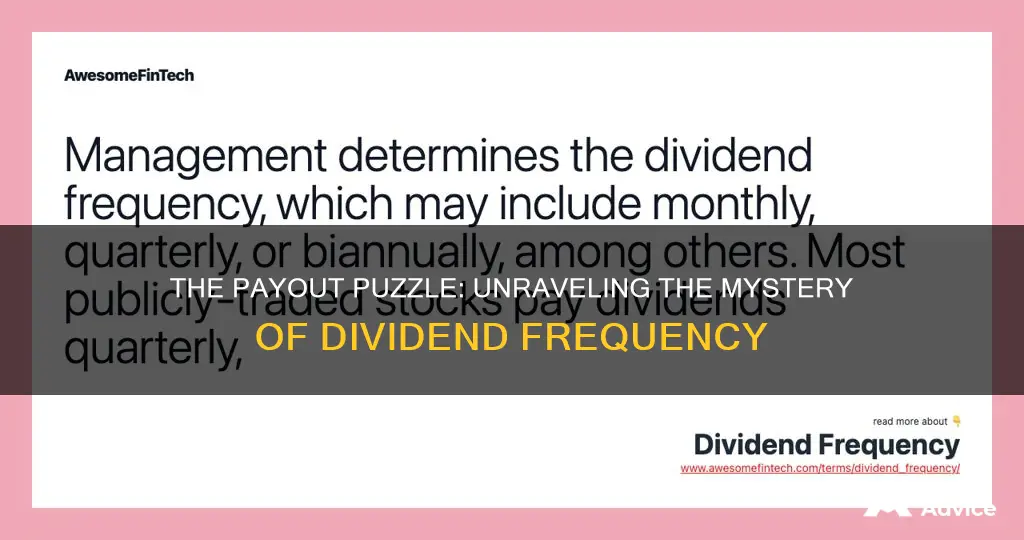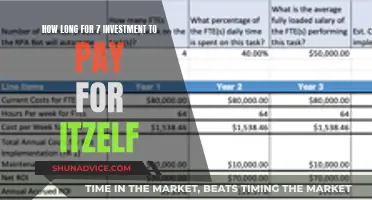
Dividends are regular payments made by companies to investors who own their stock. Dividends are usually paid quarterly, but some companies pay dividends every month, every six months, or annually. There are also one-time payments called special dividends, which are usually paid out in special circumstances.
Dividends are a way for companies to distribute profits to their shareholders, but not all companies pay dividends. Some companies may decide to retain their earnings to reinvest for growth opportunities instead.
If a company decides to pay a dividend, it will declare the dividend amount and the date it will be paid to shareholders. The dividend payment and date are typically determined on a quarterly basis, after the company finalises its income statement.
| Characteristics | Values |
|---|---|
| How often are dividends paid? | Most stocks that pay dividends pay them every three months (quarterly). However, some pay every six months (semi-annually), once a year (annually), monthly, or on no set schedule (irregular). |
| When are dividends paid? | Companies that pay a dividend every three months tend to do it after they release their quarterly earnings report. The date it is paid is called the payment date. Other important dates include the declaration date, ex-dividend date, and record date. |
| How to get your dividend payment | There are three common ways to receive a dividend payment: deposited into your brokerage account, mailed via a check, or turned into shares via dividend reinvestment programs. |
| How much is the dividend payment? | The amount paid as dividends varies between companies. To calculate how much a stock pays per quarter, divide the annual payment by four. To calculate the dividend yield of a stock, divide the annual amount by the stock price. |
What You'll Learn

Dividend frequency
The most common dividend frequency is quarterly, with companies typically paying dividends every three months after releasing their quarterly earnings report. The dividend payment date is known as the payment date, but there are several other important dates that investors should be aware of:
- Declaration date: The day the company's board of directors declares the dividend and announces the amount to be paid and the relevant dates.
- Ex-dividend date: The date after which shareholders who purchase the stock will no longer receive the next dividend payment.
- Record date: The date the company checks who should receive the dividend, usually the day after the ex-dividend date.
- Payment date: The date the dividend is paid out to shareholders, typically about a month after the ex-dividend date.
To receive a dividend payment, investors must purchase the stock before the ex-dividend date. The dividend is then typically deposited directly into the investor's brokerage account, although some companies also offer dividend reinvestment programs, which allow investors to receive their dividends in the form of additional shares.
Airlines: Where to Invest Now
You may want to see also

Dividend declaration
The declaration date is followed by the ex-dividend date, the record date, and the payment date.
The ex-dividend date is the most important date for investors. If you buy the stock before this day, then you will get paid. The record date is usually the day after the ex-dividend date. The company checks who should receive the dividend on this day. The payment date is the day the dividend is paid out to shareholders, often about a month after the ex-dividend date.
To clarify, you need to buy the stock before the ex-dividend date to receive the payment. For example, consider a stock with an ex-dividend date of January 2nd. In this case, you will get the dividend if you buy the stock prior to that date and hold it until the next day. This is because you were a "shareholder of record" on the ex-dividend date. Even if you decide to sell the stock when the market opens on January 2nd, you will still get paid.
However, you should know that the stock price drops by the same amount as the dividend amount on the ex-dividend date. Therefore, buying right before and then selling on the ex-dividend date is not a profitable strategy.
Seeking Investors for Your Farm?
You may want to see also

Dividend payment methods
Dividends are regular payments made by companies to their investors or shareholders. Dividend payment methods vary, with the most common being cash, paid either by electronic transfer or check. Dividends can also be paid out as new shares of stock, or as other company assets such as property, though these methods are less common.
Companies that decide to pay dividends typically use one of three methods: the residual dividend policy, the stable dividend policy, or a hybrid of the two.
Under the residual dividend policy, companies rely on internally generated equity to finance new projects. Dividend payments are made from the residual or leftover equity after all project capital requirements are met. This allows companies to reinvest their retained earnings before returning funds to shareholders. However, this method can lead to inconsistent and sporadic dividend payouts, resulting in volatility in the company's stock price.
The stable dividend policy, on the other hand, involves companies consistently paying dividends each year, regardless of earnings fluctuations. This method provides stability and reduces uncertainty for investors. Companies may set a target payout ratio, which is a percentage of earnings paid to shareholders in the long term.
The hybrid approach combines the residual and stable dividend policies. Companies using this method establish a set dividend, representing a small portion of yearly income, and can easily maintain it. In addition, they may offer an extra dividend when income exceeds certain benchmarks.
Investing in Corporations: Why?
You may want to see also

Dividend amount
The dividend amount is calculated by taking the annual per-share dividend and dividing it by the price of the stock. This gives a percentage, or yield, which can be used to compare dividend opportunities across different companies.
For example, if a company pays an annual dividend of $2.64 and the stock price is $100, the dividend yield would be 2.64%.
It is important to note that dividends are not guaranteed and companies may cut or eliminate dividend payments altogether due to financial difficulties.
Southwest Airlines: Invest or Avoid?
You may want to see also

Dividend yield
For example, consider two companies that both pay $1 per share. If one company's stock price is $30, and the other's is $20, the first company's dividend yield is 3.3%, and the other's is 5%. The company with the higher yield looks like a better investment because it shows a 5% return. However, it is important to note that the dividend yield can be affected by the company's share price. A healthy company may attract more investors, pushing the share price up ahead of a dividend increase, which would lower the dividend yield.
When comparing dividend yields across industries, it is important to note that average yields can vary significantly. For example, the average dividend yield for the basic materials industry may be different from the financial services industry. Therefore, it is recommended to compare dividend yields of companies operating in the same industry.
Overall, dividend yield is a useful metric for investors to evaluate potential investment opportunities and determine which stocks align with their investment strategy.
Retirement Strategies of the Rich
You may want to see also







